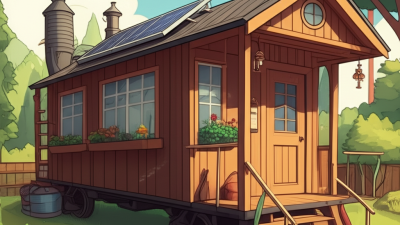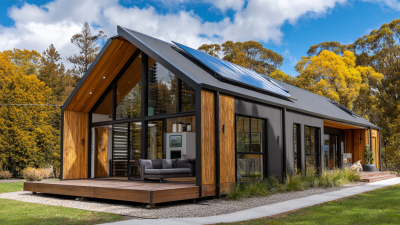2025 Top Digital Trends Shaping the Future of Boxcar Homes and Sustainable Living
As we approach 2025, the intersection of digital innovation and sustainable living continues to gain momentum, with boxcar homes emerging as a significant trend in the housing sector. With the global population expected to reach approximately 9.7 billion by 2050, as reported by the United Nations, the demand for affordable and eco-friendly housing solutions has never been more pressing. Boxcar homes, characterized by their modular designs and efficient use of space, offer a compelling answer to this challenge, blending innovative technology with sustainable practices.
According to the latest data from the International Energy Agency, buildings account for nearly 40% of global energy consumption, highlighting the urgent need for greener residential solutions. The design and construction of boxcar homes are increasingly relying on smart technologies and sustainable materials, significantly reducing their environmental footprint. Emerging trends such as prefabrication and the integration of renewable energy sources are reshaping how we conceive of living spaces, making boxcar homes not only a trend but a necessary evolution in sustainable living.
With a shift towards minimalism and an increased awareness of environmental issues, consumers are gravitating towards homes that not only resonate with their values but also reflect their lifestyle choices. As we explore the digital trends shaping the future of boxcar homes, it becomes evident that technology and sustainability are poised to redefine what it means to live responsibly and affordably in the modern age.

Future-Ready Boxcar Homes: Embracing Modular Design Innovations
Modular design innovations are at the forefront of the evolution of boxcar homes, setting a new standard in sustainable living. These homes, characterized by their efficient and flexible construction, allow for a seamless integration of eco-friendly materials and technologies. As the demand for affordable and sustainable housing rises, modular designs not only reduce waste during construction but also streamline the building process, significantly cutting down on time and resources used. This efficiency is crucial in addressing the pressing global housing crisis.
Moreover, future-ready boxcar homes are increasingly incorporating smart technologies that enhance energy efficiency and promote sustainable living practices. From solar panels to rainwater harvesting systems, these homes are designed to minimize their environmental footprint. The ability to customize living spaces according to personal needs while maximizing functionality is another significant advantage of modular design. This adaptability ensures that as lifestyles change, the homes can evolve without the need for major renovations, making them a forward-thinking solution for modern living.
2025 Top Digital Trends Shaping the Future of Boxcar Homes
This chart illustrates the predicted adoption rates of various innovations in sustainable living and modular home design expected by 2025. The advancements include modular homes, energy efficiency solutions, smart technology integration, sustainable materials, and water conservation techniques.
Sustainable Construction Materials: The Shift Towards Eco-Friendly Resources
The shift towards eco-friendly resources in the construction industry is a defining trend as we approach 2025. The demand for sustainable construction materials is escalating, driven by a collective commitment to reduce environmental impact and promote eco-conscious building practices. Notably, bio-based materials and recycled resources are at the forefront of this transformation. These materials not only reduce carbon footprints but also contribute to a circular economy, where waste is minimized and resource use is optimized.
Market forecasts indicate that the global green building materials market is set to grow significantly, with projections estimating it will reach USD 1,078.35 billion by 2034. This growth reflects a broader societal shift towards sustainability, influenced by consumer preferences and corporate responsibility. Innovative developments in eco-friendly construction materials, such as bamboo and other sustainable alternatives, are gaining traction, marking an exciting evolution in how we approach building homes and communities. As the industry embraces these changes, the integration of sustainable materials will play a critical role in shaping the future of not only boxcar homes but the entire real estate sector.

Smart Home Technology: Enhancing Efficiency in Boxcar Living
As the trend of boxcar homes gains momentum, smart home technology emerges as a key player in enhancing the efficiency of sustainable living. By 2025, it is projected that over 90% of new homes will have integrated smart technology, significantly improving energy management and user convenience. Innovations like smart thermostats and automated lighting systems not only reduce utility bills but also promote a sustainable lifestyle by minimizing energy waste. According to industry reports, these technologies can lead to energy savings of up to 30%, making them a vital component in the design of modern boxcar homes.
Incorporating smart appliances can further streamline daily tasks, catering to the minimalist lifestyle that many boxcar dwellers embrace. For instance, smart refrigerators can monitor food inventory and suggest meals, while voice-activated assistants can control home systems effortlessly. As we shift towards more compact living solutions, the integration of these technologies not only amplifies comfort but also aligns with ecological principles, encouraging residents to lead a life that honors both adventure and sustainability. With the convergence of boxcar homes and smart home technology, the future promises an exciting blend of efficiency and simplicity, allowing individuals to truly "play house" while making a meaningful impact on their environments.
Community-Centric Living: The Rise of Cohousing and Shared Spaces
As we move towards a more sustainable future, the concept of community-centric living is gaining traction, especially in the realm of cohousing and shared spaces. These innovative housing solutions emphasize collaboration and interdependence, allowing residents to share resources, spaces, and even responsibilities. This model not only reduces individual carbon footprints but fosters a sense of belonging and support among neighbors, essential for well-being in an increasingly isolated world.
Tips for creating a community-centric living environment include starting with shared goals among residents. Organize community meetings to discuss sustainable practices and collective interests. Additionally, design shared spaces like gardens, workshops, or recreational areas that encourage interaction. These not only serve practical purposes but also facilitate social connections, reinforcing the idea that you’re part of a thriving community rather than just isolated units.
Moreover, investing in eco-friendly infrastructure can significantly enhance the sustainability of your cohousing project. Consider integrating solar panels, rainwater collection systems, and community composting initiatives. These features not only lower overall energy costs but also promote a culture of environmental stewardship. By working together, residents can create a vibrant, sustainable living environment that not only benefits individual families but also contributes positively to the larger community and planet.

Renewable Energy Solutions: Powering Boxcar Homes with Sustainability in Mind
As the trend towards sustainable living continues to gain momentum,
boxcar homes are emerging as a practical and eco-friendly housing solution. Central to this evolution is
the integration of renewable energy sources, allowing these compact
dwellings to operate in harmony with the environment.
Solar panels, wind turbines, and energy storage systems are becoming increasingly accessible,
transforming boxcar homes into self-sufficient units that minimize their carbon footprint.
Tips for maximizing renewable energy in boxcar homes include the installation of solar panels on the roof to capture sunlight effectively,
ensuring optimal orientation and tilt for maximum efficiency. Additionally, incorporating energy-efficient appliances and smart home technology can significantly reduce energy consumption,
allowing residents to monitor and manage their energy use in real-time.
Another critical factor is the use of high-quality insulation and energy-efficient windows,
which help to maintain comfortable indoor temperatures while minimizing the need for
excessive heating or cooling. By prioritizing these renewable energy solutions,
homeowners can enjoy a sustainable lifestyle that not only contributes to ecological preservation but also offers
economic benefits through reduced energy bills.


